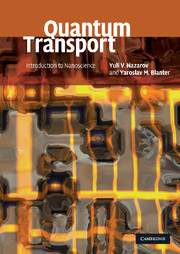We devoted Chapter 1 to a purely quantum-mechanical approach to electron transport: the scattering approach. Electrons were treated as quantum waves that propagate between reservoirs – the contact pads of a nanostructure. The waves experience scattering, and the transport properties are determined by the scattering matrix of these waves. As we have seen, this approach becomes progressively impractical with the increasing number of transport channels, and can rarely be applied for G ≫ GQ, where G is the conductance of the system.
A different starting point is well known from general physics, or, more simply, from general life experience, which is rather classical. In this context, a nanostructure is regarded as an element of an electric circuit, which conducts electric currents. If one makes a more complicated circuit by combining these elements, one does not have to involve quantum mechanics to figure out the result. Rather, one uses Ohm's law or, generally, Kirchhoff rules. The number of parameters required for this description is fewer than in the quantum-mechanical scattering approach. For example, the phase shifts of the scattering matrix do not matter.
In this chapter, we will bridge the gap between these opposite starting points. The first bridge is rather obvious: it is important to understand that these two opposite approaches do not contradict each other. In Section 2.1, we illustrate the difference and the link between the approaches with a comprehensive example of a double-junction nanostructure.
